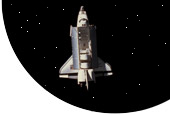Loading |
 |
|
||||||||||||||||||||||||||||||||||||||||||
September 29,2003 SPACENEWS Page 13 To minimize the chances of being blindsided by future disasters, NASA needs to open all of its eyes. But one set of visual sensors still has not been activated. Of all the lost opportunities to save the Columbia crew, perhaps the most frustrating is the failure of anyone to notice the fatal fragment of the left wing reinforced carbon-carbon (RCC) panel floating lazily away from the shuttle the day after launch. It was only recognized in post-disaster revisits of radar data, but it provided the critical link in the causal chain between insulation impact and loss of vehicle. NASA's return-to-flight plans include significant and commendable enhancements in visual monitoring of shuttles during ascent and descent, with newer and more powerful ground cameras, with on-board cameras for both real-time and playback views of the departing external tank, and with mobile trackers for entry observations. On-orbit observations of the shuttle's surface from U.S. Defense Department ground sites (and possibly from space assets) also are being prescribed. All of these helpful techniques would be significantly complemented by a methodical observation plan using television cameras already mounted on shuttles. Four cameras are in the comers of the payload bay, and two more are on the robot arm. Another is mounted centerline to look upward at docking targets. And an entire suite of handheld cameras is available for deployment in the crew cabin. These cameras have routinely been used for monitoring external equipment, for observing docking targets and for sightseeing. On occasion, they have also spotted unusual objects - presumably pieces released in the payload bay during payload deployments, spewing fuel droplets from a thruster leak, even fragments of insulation blankets. In such cases, ground controllers sometimes slew the camera and zoomed in, out of curiosity (and boredom). But NASA needs a deliberate plan to visually monitor the space near the shuttle, to try to catch such unusual objects which might - and in Columbia's case, definitely did - have major significance for some malfunction that needs attention. The Apollo program had exactly such an analysis effort. All video and photographic imagery out the windows was analyzed to detect and attempt to identify sources of objects seen outside. This happened so frequently that the moniker ‘moon pigeon’ was used to refer to them. In all cases, such objects were traced back to detached thermal blankets, to snowflakes from leaking fluids - usually propellant or water from flash evaporators - or to unexpected shrapnel from pyrotechnic separators. Anything unexpected like that was something the engineers sincerely wanted to know, and they kept their eyes wide open for every possible sighting. But on shuttle flights in the past 20 years, the only people apparently paying regular attention to funny objects seen on external shuttle cameras were UFO nuts convinced they were seeing alien attacks. Hundreds of their Internet sites have imagery from dozens of space missions, showing what space professionals easily recognize as normal space junk. Recognizing them for what they probably are isn't the problem - realizing their potential significance for shuttle safety is a serious problem. Here is where a shuttle-based sky watch activity is needed. The effort need not impact shuttle crew workload, since cameras and communications channels are controllable from Mission Control in Houston. What is needed is a plan to glance in various directions around the shuttle at regular intervals. The view forward can be supplemented by a camera mounted in a forward cabin window. The view downward might be available, at least for a short period after reaching orbit before its doors are closed, from the camera now installed to view separation of the external tank - and it is already being rewired to allow transmission of images realtime to the crew cabin. If keeping that door open longer is deemed too dangerous, small rocketcam-type imagers could be mounted on deployable structures such as the Ku-band antenna or the forward outer corners of the payload bay doors. For safety purposes of detecting shedding of unexpectedly large objects -like the missed clue of the RCC panel fragment on Columbia last January - it is not necessary to scan the full sky. This is because convenient principles of orbital flight will concentrate such departing debris into a narrow, easily monitored zone. Differential drag is a feature of close-order formation flying in orbit. Whichever object has a higher drag (smaller and lighter, usually) will lose energy much more quickly and slip closer toward Earth. There it moves into a lower, faster orbit and pulls ahead. Debris shed from shuttles often is tens of feet below and many hundreds of feet in front within an hour of departure. Every orbit, nature provides the perfect sunlight conditions to scan that zone. Moving into sunset, with all nearby objects still illuminated but the Earth background pitch dark, a shuttle-mounted camera can see anything in that zone bigger than an inch or so in size. Two separate camera views can provide gross parallax ranging. If something unusual is spotted, something bright and flashing as it tumbles, it can be quickly observed with magnification by the shuttle crew. Ground radar tracking could be called up. If it is still worrisome - or, say, its appearance was preceded by some other unusual events -- the shuttle could with some considerable effort chase it down and observe it at close range. The Columbia catastrophe gave us all the reasons we need to keep all of our eyes open to forestall future recurrences. But detecting unusual departing objects from the shuttle - and from the space station, for that matter - has an even wider application to the situational awareness needed for safe operations. Pieces might merely represent structural failures requiring repair or redesign. They might indicate leaks in propellant leaks or coolant loops, often before any other instrumented readings. And they might be objects, such as the dropped Extravehicular Activity tool on the station in early 2001 that threatened to circle back and recontact the station, requiring that it fire rockets to move out of the way. James Oberg is the Houston-based author of the book "Star-Crossed Orbits: Inside the US/Russian Space Alliance" |
home | profile | articles | books | lectures | jim speaks | humor
links | email
Copyright 2010 James Oberg. All Rights Reserved
Site Designed and Maintained by YoeYo.com
